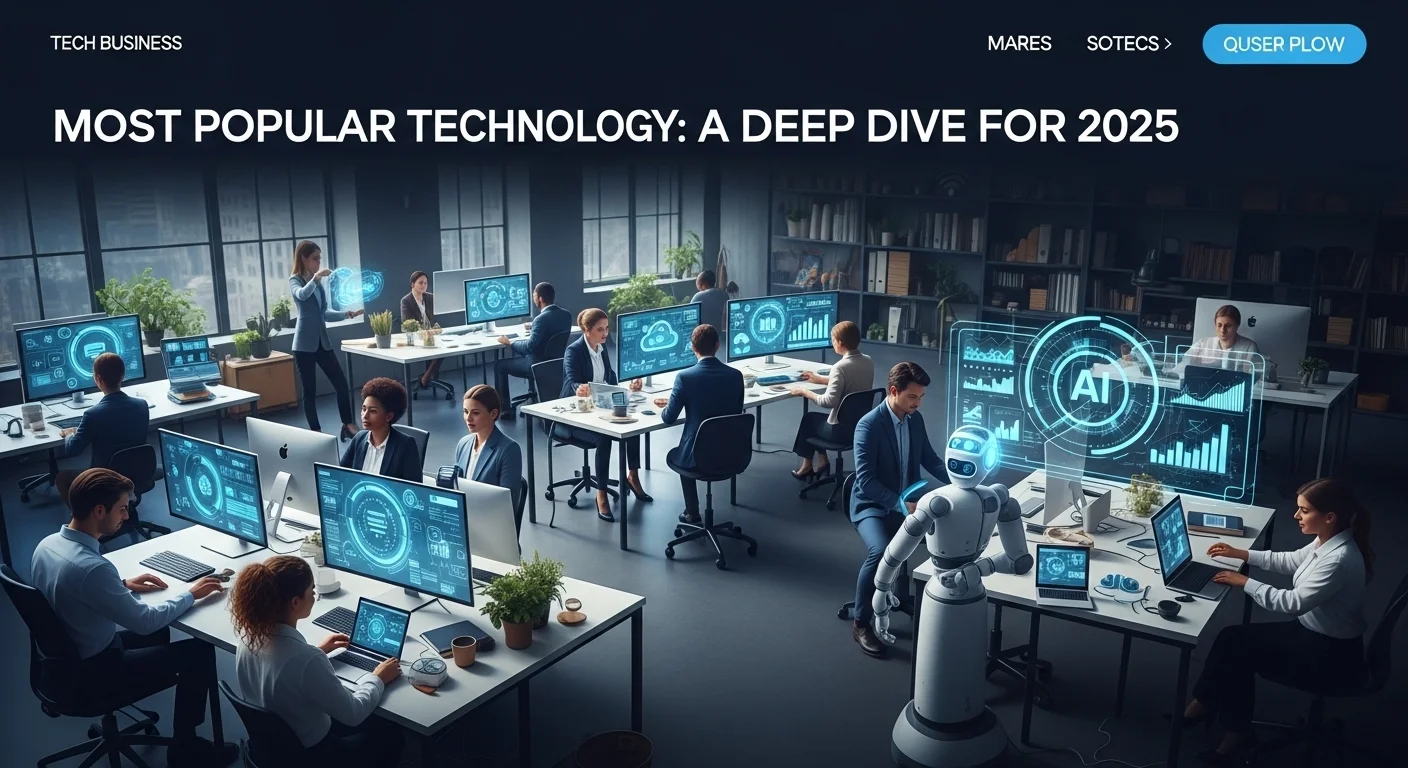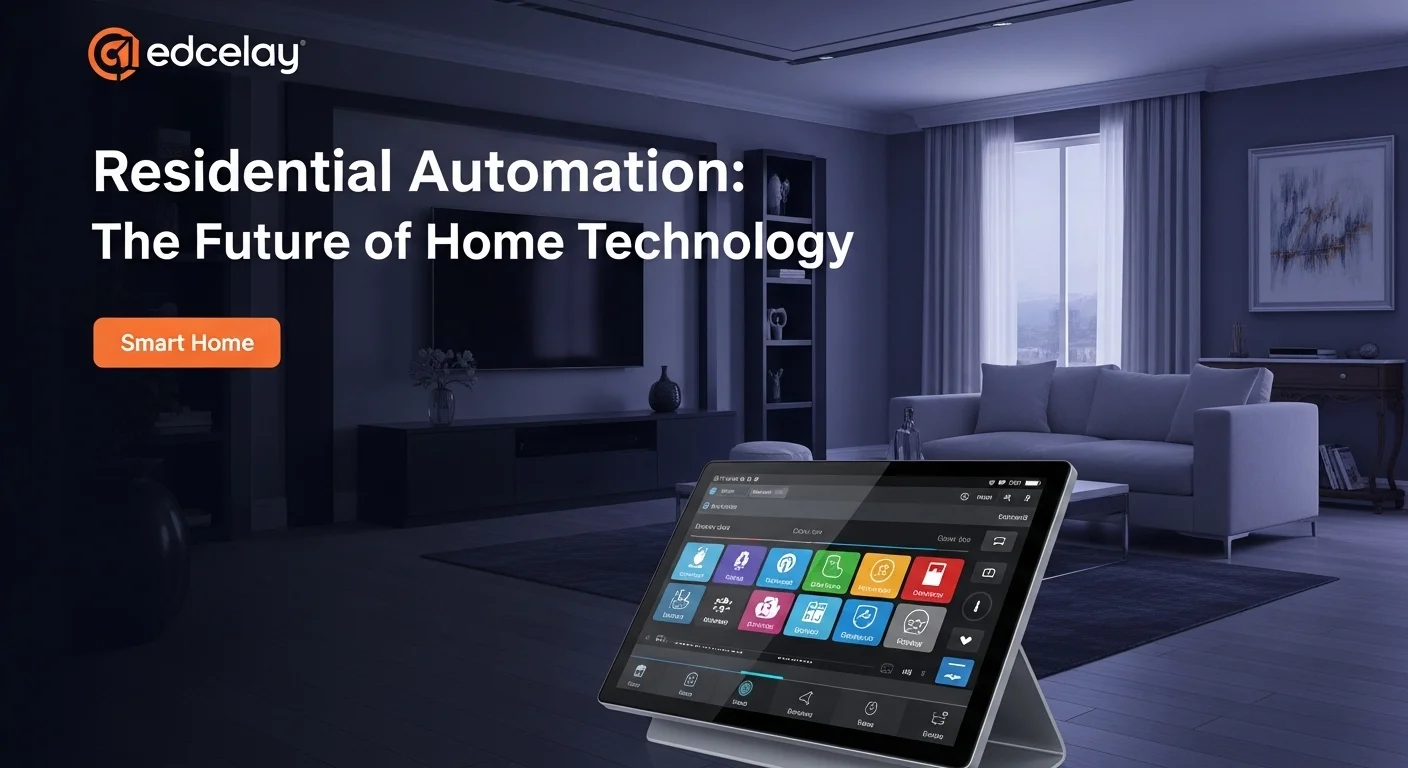Beyond the Hype: A Practical Guide to Popular Technology in 2025

Executive Summary
I've spent over two decades in the tech industry, and if there's one word that gets thrown around too much, it's 'popular'. But what does it actually mean? It's not just about what's trendy; it's about what works, what's reliable, and what will actually help your business grow. In this article, I’m going to pull back the curtain and show you what 'popular' really means in tech. We'll look at the foundational tools like cloud computing and AI that are fueling today's smartest startups and helping small businesses compete. We'll also dive into the consumer world, like the race to dominate the smart home. My goal is simple: to give you a clear roadmap for making smart tech decisions, whether you're an entrepreneur looking for your next big idea or a professional trying to stay ahead of the curve.
Table of Contents
Table of Contents
- What 'Popular' Really Means in Technology
- How We Measure What's Hot: The Real Metrics
- The Ripple Effect on Business and Franchising
- Your Guide to Top Tech and Business Solutions
- The Cloud: Your Business's Digital Foundation
- AI and Machine Learning: The Brains of the Operation
- The Battle for the Smart Home
- Finding Your Niche: Startups and Franchising
- Actionable Tips to Improve Your Tech Experience
- Strategy 1: Match the Tech to Your Mission
- Strategy 2: Think in Ecosystems, Not Just Products
- Strategy 3: Make Security and Privacy Your Priority
- Strategy 4: Plan for Growth and Future Trends
What 'Popular' Really Means in Technology (and Why It Matters)
In the world of tech, 'popular' means more than just being a flash in the pan. It's a powerful signal that a technology is stable, supported, and valuable. I've learned that it represents a powerful combination of user adoption, developer support, and real-world success. A technology becomes popular because it genuinely solves a problem better than the alternatives. It's the market's way of voting for a winner, whether that's a cloud provider, a programming language, or the leading smart home ecosystem. Understanding this is vital because it shows you where the smart money is going and where future opportunities lie.
From a business standpoint, especially for a small or growing company, aligning with popular tech is a powerful survival strategy. It’s about leveraging the network effect: the more people who use a technology, the more valuable and reliable it becomes. Think about it—you get larger support communities, more ready-made integrations, and a bigger pool of talented people who know how to use it. When a small business I advised switched to a widely-used CRM, they weren't just buying software; they were plugging into a massive ecosystem of support and add-ons that de-risked their investment and saved them countless headaches.
This drive for popularity is what fuels the incredible pace of innovation in our industry. Companies are constantly competing to build better products, which drives quality up and prices down for everyone. This is the fertile ground where innovative startups are born. Often, they build their entire business on an existing popular platform, like AWS or Google Cloud, allowing them to scale at a speed that would have been unimaginable a decade ago. They leverage the popularity of the giants to build their own success, creating a dynamic and healthy tech economy.
How We Measure What's Hot: The Real Metrics
So how do we actually measure popularity beyond just a gut feeling? It's a blend of several key indicators that, together, paint a clear picture:
- Market Share: This is the classic metric. Think of it as the scoreboard, showing who's winning in terms of sales. The ongoing battle between Android and iOS for mobile dominance is a perfect example.
- Adoption Rate: This measures how quickly people are flocking to a new technology. The explosive growth of generative AI tools like ChatGPT showed an adoption curve so steep it was a clear signal of a major shift.
- Developer Love: In software, developers are the ultimate kingmakers. I always keep an eye on developer activity—things like discussions on Stack Overflow or projects on GitHub. When developers are excited about a tool, it's a strong sign of its health and future potential.
- Public Interest: Simple tools like Google Trends are surprisingly insightful. A steady, high volume of searches and positive chatter on social media indicate a technology has broken into the mainstream.
- Ecosystem Strength: A truly popular technology has a whole universe built around it. A rich marketplace of plugins, apps, and certified professionals is a sign of a mature and 'sticky' platform that users are committed to.
Using this data-driven view allows businesses to make strategic bets based on evidence, not just hype. It's how investors spot the next unicorn and how smart entrepreneurs identify business ideas in the gaps between what a popular technology offers and what a specific market needs.
The Ripple Effect on Business and Franchising
The influence of popular tech creates entire business models. Take franchising, for example. The most successful tech franchises are often built around supporting the most widely used technologies. I've seen businesses like TeamLogic IT thrive by offering expert help for the exact tools—Microsoft 365, cloud security—that nearly every small and medium business relies on. They've built a successful, scalable model on a foundation of established, widespread demand.
This isn't limited to IT support. We're seeing franchises for drone services, 3D printing, and even kids' coding schools. They all succeed by packaging a service around a technology that has reached a critical mass of popularity. The franchise model works by giving entrepreneurs a proven playbook to tap into that existing market, lowering the barrier to entry.
The rise of Software as a Service (SaaS) itself is a product of this phenomenon. Companies create a scalable solution built on popular, standardized infrastructure (the cloud and the internet) and sell it via subscription. This has become the go-to model for so many successful startups, giving them predictable revenue and global reach from the get-go.
On the consumer front, the dynamic is just as intense. The smart home market is a fascinating battleground where Amazon, Google, and Apple are all fighting to become the central hub for our connected lives. The winner won't just sell speakers; they'll control the platform that all other devices plug into. For consumers, choosing a system is a big deal, because you're investing in an ecosystem. Here, the winning factors are often user experience and the sheer number of compatible devices. Amazon's Alexa got a huge head start not by being the most technically perfect, but by being simple, affordable, and by masterfully encouraging other companies to build integrations. This shows that in any arena, understanding what drives popularity is the key to spotting opportunities and making smart, strategic decisions.

Your Guide to Top Tech and Business Solutions
Alright, now that we understand why popularity matters, let's get into the specifics. This is your practical guide to the technologies and business models that are currently defining the landscape. Think of this as a map to help you navigate, whether you're launching a groundbreaking startup or looking to equip your small business with the right tools for growth. We'll break down the dominant forces and show you how to leverage them.
The Cloud: Your Business's Digital Foundation
Over the past two decades, cloud computing has gone from a novel idea to the absolute bedrock of modern business. For any ambitious small business today, using the cloud isn't just an option; it's essential. It provides the power to scale, control costs, and access top-tier tools without buying and maintaining a room full of servers.
The Titans of the Cloud: AWS, Azure, and Google Cloud
The cloud space is led by three giants. Choosing between them is like picking a general contractor for your digital house—each has unique strengths:
- Amazon Web Services (AWS): The original market leader, AWS is like the sprawling, everything-included hardware store. It has the widest range of tools and the most mature platform. I've seen countless startups build on AWS because they know it can handle any scale they throw at it, from day one to a billion users.
- Microsoft Azure: Azure is like the contractor who already has a deep relationship with your corporate building. Its biggest advantage is its seamless integration with the Microsoft software so many businesses already use, like Office 365. For established companies, this makes Azure a very popular and logical choice.
- Google Cloud Platform (GCP): Think of GCP as the high-tech specialty shop. While third in market share, it's a powerhouse in data analytics, AI, and machine learning. I often recommend GCP to companies whose business model is built around making sense of massive datasets.
For most businesses, any of these platforms is a safe bet because their popularity guarantees a wealth of support, documentation, and skilled professionals.
AI and Machine Learning: The Brains of the Operation
Artificial Intelligence has officially left the lab and entered the workplace. It's no longer science fiction; it's a practical tool that's becoming the engine for some of the most clever business ideas today, from AI-powered marketing assistants to automated customer service agents.
Popular AI Applications in Business:
- Smarter Customer Relationships: AI is giving CRMs a major upgrade. It can analyze customer behavior to predict who might leave, spot sales opportunities, and run personalized marketing campaigns automatically.
- Next-Level Cybersecurity: AI security systems work 24/7 to spot unusual activity on your network, identify new threats, and respond faster than any human team possibly could.
- Automating the Grunt Work: From processing invoices to scheduling appointments, AI is great at handling repetitive tasks. This frees up your team to focus on creative, strategic work that actually grows the business.
The Battle for the Smart Home
The race to create the ultimate connected home is one of the most visible tech battles today. The platform that wins will become the central operating system for our daily lives, linking everything from our lights to our security.
Comparing the Smart Home Ecosystems:
Here’s my breakdown of the main players:
| Feature | Amazon Alexa | Google Assistant/Home | Apple HomeKit |
|---|---|---|---|
| Device Compatibility | The biggest playground. Thousands of third-party devices and 'skills' connect to it. | Huge and growing list of devices, with fantastic integration for Nest products. | A smaller, more exclusive club. Devices are carefully vetted for security (MFi certified). |
| Strengths | First-to-market advantage, deep e-commerce integration, massive device selection. | Best-in-class for understanding natural conversation and leveraging Google's search power. | Unmatched focus on user privacy and security, with flawless integration for Apple users. |
| Best For | People who want the absolute widest choice of gadgets and integrations. | Users deep in the Google/Android world who value a smarter, more conversational assistant. | Apple loyalists who prioritize privacy and a seamless experience across their devices. |
The popularity of these systems has created a cottage industry of installers, security consultants, and developers, proving again how a popular consumer technology can create waves of new business opportunities.
Finding Your Niche: Startups and Franchising
If you pay attention to popular tech, you can spot incredible business opportunities. The most successful tech franchises, for example, often pop up to support a technology that has become essential. Think of all the cell phone repair shops that emerged after smartphones went mainstream. They succeeded by solving a common problem created by a popular product.
For aspiring innovators, I've noticed successful startups tend to follow one of two paths:
- Building on a Platform: They create something that thrives within an existing, popular ecosystem. This could be a hit app on the App Store, a business tool on the Salesforce marketplace, or even a popular YouTube channel.
- Applying Popular Tech to a New Problem: They take a mature technology like AI or IoT and apply it to a different field, like using AI to improve medical diagnostics or IoT sensors for better farming. They leverage the power of the tech to innovate elsewhere.
By looking at what's popular, you can see where the river is flowing. The key is to ask, 'What new problem can this solve?' or 'What old process can this make ten times better?' The answers are often where the next great businesses are born.

Actionable Tips to Improve Your Tech Experience
Knowing what's popular is one thing. Using that knowledge wisely is another. I've seen too many businesses chase shiny objects without a plan, leading to wasted money and a messy collection of tools. To truly benefit, you need a strategy. Here are my tried-and-true principles for making sure your tech choices actually pay off, whether for your business or your home.
Strategy 1: Match the Tech to Your Mission
This is my number one rule. Before you adopt any new technology, no matter how much buzz it has, you must connect it to a specific goal. Ask yourself these questions:
- What problem am I actually solving? Don't adopt AI just to say you have AI. Define the mission. Is it to cut customer response time by 50%? To generate first drafts for marketing emails? Be specific.
- How does this fit with my current setup? A powerful new tool that doesn't talk to your existing systems is worse than useless; it creates more work. Always look for good integrations or a robust API.
- What's the real cost? The sticker price is just the start. You have to account for the cost of training, implementation, and ongoing maintenance. The 'cheap' tool can quickly become the most expensive one.
- How will I know if it's working? Define your success metrics from day one. For a new project management tool, that might be fewer missed deadlines. For a marketing platform, it could be more qualified leads.
This discipline is what separates the businesses that thrive with technology from those that are buried by it. It ensures every dollar you spend on tech is a purposeful investment.
Strategy 2: Think in Ecosystems, Not Just Products
The most powerful technologies are rarely alone. They sit at the center of a vibrant ecosystem. When you choose a platform like Microsoft 365, Salesforce, or even a smart home system like Google Home, you're getting more than a product. You're gaining access to a network of apps, developers, and experts.
How to Tap Into the Ecosystem:
- Check the Marketplace First: Before you pay for a custom-built solution, always explore the platform's official app store (like the Salesforce AppExchange or Google Workspace Marketplace). Chances are, someone has already built an affordable, well-reviewed solution for your exact problem.
- Join the Community: Dive into user forums, watch webinars, and follow the experts on social media. This is a goldmine for troubleshooting, learning best practices, and seeing how others are solving problems like yours.
- Invest in Expertise: For your core business systems, having someone on your team who is certified can be a massive advantage. It ensures you're squeezing every drop of value out of the technology.
When you think in terms of ecosystems, you dramatically increase the return on your tech investments and build your business on a more stable foundation.
Strategy 3: Make Security and Privacy Your Priority
Popularity is a magnet for attention—both good and bad. Widely used software is a prime target for cybercriminals. That's why a security-first approach isn't optional; it's essential.
My Core Security Practices:
- Use Multi-Factor Authentication (MFA): This is the single most effective security step you can take. Turn it on for every important service, especially email and financial apps. No exceptions.
- Practice the Principle of Least Privilege: People should only have access to the data and systems they absolutely need to do their jobs. Regularly review these permissions.
- Automate Updates: Set all your software and operating systems to update automatically. This is the easiest way to patch security holes before they can be exploited.
- Train Your Team: Your people are your first line of defense. Regular training on how to spot phishing scams and handle data safely is one of the best investments you can make.
If you're launching a new business, building a reputation for rock-solid security from the start can be a powerful way to earn customer trust and stand out from the competition.
Strategy 4: Plan for Growth and Future Trends
The tech you choose today needs to be able to grow with you. This is crucial for startups that might experience explosive growth, but it's just as important for any ambitious business.
How to Future-Proof Your Tech:
- Choose Cloud-Native: Cloud-based platforms are built for scale. They let you expand your capacity with a few clicks instead of buying and installing new hardware.
- Demand a Good API: Whenever possible, choose tools with a well-documented Application Programming Interface (API). This is your key to connecting tools and building custom workflows as your needs become more complex.
- Stay Curious: The tech world moves fast. I set aside time every week to read up on what's next. Following reputable tech news sites, industry analysts, and even informed commentators on social media can give you a crucial edge. A great resource for high-level analysis is the Gartner Newsroom.
By keeping one eye on the future, you can avoid getting stuck with outdated technology and ensure your business stays agile. This forward-thinking approach is how you go from simply using popular tech to capitalizing on the next wave of innovation.
Expert Reviews & Testimonials
Sarah Johnson, Business Owner ⭐⭐⭐
This was a solid overview, but as a small business owner, I would have loved to see more real-world case studies or examples I could directly apply to my company.
Mike Chen, IT Consultant ⭐⭐⭐⭐
A great read on popular tech. It clarified a lot for me, though a few of the more technical concepts could have been broken down a bit more simply.
Emma Davis, Tech Expert ⭐⭐⭐⭐⭐
Fantastic article! As a tech professional, I found this incredibly comprehensive and well-explained. It's a perfect resource for anyone in the field. I understood everything perfectly.



